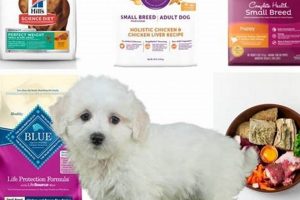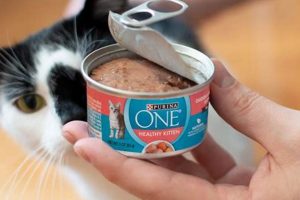Selecting optimal nutrition for a young, large-breed canine is a critical element in ensuring proper growth and development. This selection process requires careful consideration of specific nutritional needs to support skeletal health, prevent rapid growth spurts, and minimize the risk of developmental orthopedic diseases common in these breeds. The aim is to provide a diet that meets energy requirements without over-supplementation of certain minerals.
Providing appropriate nourishment during the crucial puppy stage can significantly impact long-term health and well-being. Historically, improper feeding practices have been linked to increased susceptibility to conditions such as hip dysplasia, osteochondrosis, and hypertrophic osteodystrophy in giant breeds. A balanced diet, formulated to control growth rate and maintain lean body mass, offers substantial advantages for a healthy lifespan.
Therefore, the following discussion will explore key factors in choosing suitable nourishment, including considerations for protein levels, calcium-to-phosphorus ratios, and appropriate calorie density. The importance of consulting with a veterinarian for personalized dietary recommendations will also be emphasized to ensure the specific needs of each individual puppy are adequately met.
Nutritional Guidelines for Great Dane Puppies
Proper nutrition is paramount for the healthy development of Great Dane puppies. The following guidelines outline crucial aspects of selecting and managing their diet to minimize risks associated with rapid growth.
Tip 1: Select a Large-Breed Specific Formula: Choose a food explicitly formulated for large-breed puppies. These formulas are designed to regulate growth rates and provide appropriate levels of calcium and phosphorus.
Tip 2: Monitor Protein Content: While protein is essential, excessive amounts can contribute to rapid growth. Aim for a protein content within the range recommended for large-breed puppies, typically between 23-26% on a dry matter basis.
Tip 3: Maintain an Appropriate Calcium-to-Phosphorus Ratio: This ratio is crucial for skeletal development. Strive for a calcium-to-phosphorus ratio between 1.1:1 and 1.4:1. Avoid over-supplementation with calcium, as this can disrupt bone formation.
Tip 4: Control Calorie Intake: Overfeeding can lead to excessively rapid growth. Adhere to the feeding guidelines provided by the food manufacturer, adjusting portions as needed based on the puppy’s body condition and activity level.
Tip 5: Divide Meals into Multiple Feedings: Feeding smaller, more frequent meals throughout the day can help prevent bloat (gastric dilatation-volvulus), a life-threatening condition common in large breeds.
Tip 6: Avoid Supplementation Unless Directed by a Veterinarian: Unless specifically recommended by a veterinarian due to a diagnosed deficiency, avoid adding supplements, as this can disrupt the carefully balanced nutrient profile of the chosen food.
Tip 7: Regularly Assess Body Condition: Regularly evaluate the puppy’s body condition score to ensure it maintains a healthy weight. You should be able to feel the ribs easily without excessive fat covering.
These guidelines emphasize the importance of carefully managing nutrient intake to promote healthy growth and minimize the risk of developmental orthopedic diseases in Great Dane puppies. Consulting with a veterinarian is essential for personalized dietary recommendations tailored to the individual puppy’s needs.
The subsequent sections will delve into specific food ingredients and potential health considerations related to Great Dane puppy nutrition.
1. Large-Breed Specificity
The designation “large-breed specific” on canine food products signifies formulations tailored to the unique physiological needs of dogs that reach significant adult sizes. This distinction is particularly critical when selecting sustenance for Great Dane puppies due to their predisposition to rapid growth and associated skeletal disorders.
- Controlled Calcium and Phosphorus Levels
Large-breed specific diets feature precisely calibrated calcium and phosphorus levels, typically lower than those found in standard puppy foods. Excessive calcium intake can accelerate growth, leading to developmental orthopedic diseases such as hip dysplasia and osteochondrosis. The ratio of calcium to phosphorus is also meticulously balanced to promote proper bone mineralization and prevent imbalances that can contribute to skeletal abnormalities.
- Moderate Calorie Density
These diets are often formulated with a moderate calorie density to regulate growth rate. While adequate caloric intake is necessary to support energy requirements, excessive calories can fuel overly rapid growth, placing undue stress on developing joints and skeletal structures. Controlled calorie intake helps maintain a healthy weight and promotes lean muscle mass development without accelerating skeletal maturation beyond a safe pace.
- Appropriate Protein Content
While protein is essential for growth and development, large-breed specific diets contain protein levels within an appropriate range for these breeds. Excessive protein can contribute to rapid growth spurts. The focus is on providing high-quality protein sources to support muscle development and overall health without over-stimulating skeletal growth. Look for sources from animal based product such as fish and chicken.
- Glucosamine and Chondroitin Supplementation
Some large-breed specific formulas include glucosamine and chondroitin, which are compounds believed to support joint health. These supplements may help protect cartilage and reduce the risk of joint problems that can arise from rapid growth and the increased weight-bearing stresses experienced by large breeds. While the efficacy of these supplements is still under investigation, their inclusion is a common practice in diets aimed at supporting the musculoskeletal health of large-breed puppies.
The characteristics of large-breed specific diets directly address the physiological challenges associated with rapid growth in breeds like the Great Dane. These formulations aim to optimize skeletal development, minimize the risk of orthopedic diseases, and support overall health during the critical puppyhood stage. The selection of such a diet is a proactive step in ensuring the long-term well-being of a Great Dane puppy.
2. Controlled Growth Rate
A controlled growth rate is a paramount factor in determining the suitability of sustenance for Great Dane puppies. Rapid growth, often associated with excessive caloric or nutrient intake, predisposes these dogs to a range of developmental orthopedic diseases. These diseases include, but are not limited to, hip dysplasia, elbow dysplasia, osteochondrosis dissecans (OCD), and hypertrophic osteodystrophy (HOD). The aim is to provide adequate nutrition to support healthy development without accelerating skeletal maturation beyond a safe physiological pace. A proper dietary regimen prevents disproportionate weight gain relative to skeletal development, minimizing stress on developing joints and cartilage. A real-world example would be two Great Dane puppies from the same litter, where one is fed a standard puppy food ad libitum, and the other is fed a large-breed specific food in measured portions. The puppy fed the standard diet would likely exhibit faster growth, reaching a larger size sooner, but also exhibiting signs of joint pain or lameness at a younger age due to the aforementioned orthopedic issues. The other puppy, with a controlled growth rate, would mature more slowly but maintain healthier joints and a lower risk of developing those conditions.
Implementing a controlled growth rate strategy involves several key considerations. These include selecting a large-breed specific puppy food with moderate calorie density, appropriate protein levels, and carefully balanced calcium and phosphorus ratios. Portion control is also crucial. Adhering to the feeding guidelines provided by the food manufacturer, while closely monitoring the puppy’s body condition, allows for adjustments based on individual needs. Dividing the daily ration into multiple smaller meals helps to prevent rapid spikes in blood glucose levels and reduces the risk of bloat, another common and life-threatening condition in large breeds. Furthermore, routine veterinary check-ups are essential to monitor growth and development, allowing for early detection and intervention if any abnormalities arise.
In summary, the link between a controlled growth rate and the ideal nourishment for Great Dane puppies centers on mitigating the risks of developmental orthopedic diseases. This control is achieved through careful dietary selection, portion management, and consistent veterinary monitoring. Understanding and implementing these strategies is essential for promoting the long-term health and well-being of these giant breed dogs, ensuring they can enjoy a full and active life free from the debilitating effects of rapid growth-related skeletal problems.
3. Balanced Minerals
The inclusion of balanced minerals in canine diets, particularly those formulated for Great Dane puppies, is of utmost importance. Appropriate mineral ratios are fundamental to proper skeletal development, nerve function, and overall physiological processes. Deviations from established guidelines can have significant, and often detrimental, effects on a puppy’s health trajectory.
- Calcium and Phosphorus Ratio
The ratio of calcium to phosphorus is perhaps the most critical mineral consideration for Great Dane puppies. An imbalance, particularly excessive calcium, can disrupt bone remodeling and lead to developmental orthopedic diseases. The ideal ratio typically falls between 1.1:1 and 1.4:1. For example, supplementing a diet already rich in calcium can suppress the production of calcitriol, a hormone essential for calcium absorption, ironically leading to skeletal abnormalities. Maintaining this balance ensures proper bone mineralization and reduces the risk of conditions such as osteochondrosis and hypertrophic osteodystrophy.
- Zinc and Copper
Zinc and copper are trace minerals that play vital roles in immune function, enzyme activity, and coat health. However, excessive zinc can interfere with copper absorption, leading to copper deficiency. Conversely, high levels of copper can be toxic. The appropriate balance ensures optimal immune response, maintains healthy skin and coat, and prevents potential toxicities. Real-world implications include impaired wound healing and increased susceptibility to infections in puppies with zinc-copper imbalances.
- Sodium and Chloride
Sodium and chloride, as electrolytes, are crucial for maintaining fluid balance, nerve transmission, and muscle function. Excess sodium intake can lead to hypertension and exacerbate heart conditions. Insufficient sodium can disrupt fluid homeostasis and cause neurological issues. Properly balanced levels of sodium and chloride ensure adequate hydration, proper nerve function, and cardiovascular health. An example of imbalance would be over-supplementation with salt, potentially leading to kidney problems or increased thirst and urination.
- Magnesium
Magnesium is essential for muscle and nerve function, bone health, and energy production. Magnesium deficiency can lead to muscle weakness, tremors, and cardiac arrhythmias. Conversely, excessive magnesium can cause diarrhea and electrolyte imbalances. A balanced magnesium level ensures proper muscle contraction, nerve transmission, and bone metabolism. Real-world problems can present as muscle weakness if not enough magnesium intake in food.
The collective impact of balanced minerals on Great Dane puppy health cannot be overstated. The precise ratios and quantities of these minerals significantly influence skeletal development, immune function, and overall physiological well-being. Consequently, selecting a food formulated with these considerations in mind is a fundamental aspect of providing optimal sustenance for these large-breed canines.
4. Optimal Protein Content
Protein content within canine diets, specifically when selecting appropriate nourishment for Great Dane puppies, is a crucial consideration directly impacting growth and overall health. Excessive protein levels can contribute to rapid growth rates, which, as previously established, increases the risk of developmental orthopedic diseases. Insufficient protein, conversely, can hinder proper muscle development and compromise immune function. Therefore, the ideal protein content seeks to balance these competing needs, supporting healthy tissue development without accelerating skeletal maturation beyond a safe pace. A real-world example would be comparing two diets: one with 30% protein and another with 24% protein, both formulated for large-breed puppies. The puppy consuming the 30% protein diet might initially appear more muscular, but long-term studies suggest a higher propensity for skeletal issues compared to the puppy on the 24% protein diet. This highlights the importance of a balanced, rather than maximal, protein intake.
The practical significance of understanding optimal protein content extends beyond simply reading the label on a bag of dog food. It requires an appreciation for the source and quality of the protein. High-quality protein sources, such as animal-based proteins like chicken, fish, or beef, are more readily digestible and provide a more complete amino acid profile than plant-based protein sources. A diet primarily reliant on plant-based proteins may necessitate higher overall protein levels to compensate for lower digestibility and amino acid availability, potentially increasing the risk of rapid growth. Furthermore, individual metabolic differences can influence a puppy’s protein requirements, necessitating adjustments based on veterinary assessment and observation of the puppy’s body condition. For instance, a more active puppy might require slightly higher protein intake than a less active one, but within established large-breed puppy guidelines.
In conclusion, the relationship between optimal protein content and the best dietary selection for Great Dane puppies is intricate and multifaceted. It extends beyond a single percentage value, encompassing protein source, digestibility, and individual puppy needs. The challenge lies in finding the right balance, one that promotes healthy muscle development, supports immune function, and minimizes the risk of growth-related orthopedic issues. Veterinary consultation, combined with careful monitoring of the puppy’s growth and overall health, is essential to ensure that the protein content in their diet aligns with their specific requirements, contributing to their long-term well-being.
5. Digestibility
Digestibility represents a critical facet of selecting optimal sustenance for Great Dane puppies. The degree to which a food can be efficiently broken down and its nutrients absorbed directly influences the puppy’s overall health, growth trajectory, and risk of gastrointestinal distress. Inadequate digestibility can lead to nutrient deficiencies, even when the food appears nutritionally complete on paper.
- Ingredient Quality and Sourcing
The source and quality of ingredients significantly impact digestibility. High-quality protein sources, such as animal-based proteins (chicken, fish, beef), are generally more digestible than plant-based proteins. Similarly, easily digestible carbohydrates like rice are preferable to those with high fiber content. For instance, a diet heavily reliant on corn or soy may present digestive challenges, leading to increased fecal volume and reduced nutrient absorption. Conversely, a food formulated with hydrolyzed proteins, where protein molecules are broken down into smaller peptides, can enhance digestibility, particularly in puppies with sensitive digestive systems. This ensures optimal nutrient utilization, supporting healthy growth and development.
- Presence of Anti-Nutritional Factors
Certain ingredients contain anti-nutritional factors that interfere with nutrient absorption. Phytic acid, found in some grains and legumes, can bind to minerals like calcium, iron, and zinc, reducing their bioavailability. Tannins, present in certain plant-based ingredients, can inhibit protein digestion. Understanding these factors allows for informed selection of foods with minimal interference to nutrient uptake. Processing methods, such as cooking or fermentation, can reduce the impact of anti-nutritional factors, improving the overall digestibility of the food.
- Fiber Content and Type
Fiber plays a complex role in digestion. While necessary for maintaining gut health and promoting regular bowel movements, excessive fiber can dilute nutrient concentration and decrease digestibility. Soluble fiber, such as beet pulp, can aid in stool formation and promote beneficial gut bacteria. Insoluble fiber, like cellulose, adds bulk but is less digestible. The optimal fiber content balances these needs, supporting gut health without compromising nutrient absorption. An inappropriate fiber level can lead to either constipation or diarrhea, both detrimental to a puppy’s well-being.
- Enzyme Supplementation
Some canine diets incorporate supplemental enzymes, such as amylase, protease, and lipase, to aid in the breakdown of carbohydrates, proteins, and fats, respectively. These enzymes can enhance digestibility, particularly in puppies with compromised digestive function or those transitioning to solid food. The addition of enzymes can improve nutrient absorption, reduce the workload on the puppy’s digestive system, and promote overall gut health. However, it is crucial to ensure that the enzyme supplementation is appropriate for the puppy’s age and health status.
In conclusion, digestibility represents a cornerstone in identifying the sustenance suitable for Great Dane puppies. Considerations such as ingredient quality, presence of anti-nutritional factors, fiber content, and enzyme supplementation all contribute to the efficiency with which a puppy can extract nutrients from its food. Selecting a diet that prioritizes digestibility is a proactive measure in supporting healthy growth, minimizing gastrointestinal issues, and optimizing the puppy’s overall health and vitality.
6. Veterinarian Consultation
The selection of appropriate nourishment for a Great Dane puppy necessitates a nuanced understanding of breed-specific needs and individual health considerations. Therefore, veterinarian consultation assumes a pivotal role in determining the optimal dietary strategy. This professional guidance ensures that nutritional choices align with the puppy’s physiological requirements and any underlying medical conditions.
- Personalized Nutritional Assessment
A veterinarian conducts a comprehensive assessment of the puppy’s health status, considering factors such as age, weight, body condition score, activity level, and any pre-existing health issues. This assessment informs personalized dietary recommendations, tailored to the individual puppy’s needs. For example, a puppy diagnosed with a sensitive digestive system might require a specialized diet with easily digestible ingredients, while a puppy predisposed to rapid growth might benefit from a calorie-restricted formula. This contrasts with generalized dietary advice, which may not adequately address specific health concerns.
- Disease Prevention and Management
Veterinarians possess the expertise to identify potential nutritional deficiencies or excesses that could contribute to the development of health problems. They can advise on appropriate supplementation, if needed, and help manage existing conditions through dietary modifications. For instance, a Great Dane puppy genetically predisposed to dilated cardiomyopathy (DCM) might benefit from a diet supplemented with L-carnitine and taurine, which are nutrients believed to support cardiac function. This proactive approach can help mitigate the risk of disease progression and improve the puppy’s overall prognosis.
- Guidance on Food Selection and Portion Control
The vast array of canine food options available can be overwhelming for pet owners. Veterinarians can provide informed guidance on selecting appropriate commercial diets, considering factors such as ingredient quality, nutrient profiles, and life stage suitability. They can also advise on appropriate portion sizes and feeding schedules, helping to prevent overfeeding or underfeeding. This guidance ensures that the puppy receives the correct amount of nutrients to support healthy growth and development without accelerating skeletal maturation beyond a safe pace.
- Ongoing Monitoring and Adjustment
Nutritional needs evolve as a puppy grows and develops. Veterinarians can monitor the puppy’s progress through regular check-ups, assessing body condition, growth rate, and overall health. They can make necessary adjustments to the diet based on these assessments, ensuring that the puppy continues to receive optimal nutrition throughout its life. This ongoing monitoring allows for early detection and intervention if any nutritional imbalances or health problems arise, maximizing the puppy’s chances of a long and healthy life.
In summary, veterinarian consultation is an indispensable component of selecting the most appropriate sustenance for Great Dane puppies. The personalized assessment, disease prevention strategies, dietary guidance, and ongoing monitoring provided by a veterinarian are crucial for ensuring that nutritional choices align with the puppy’s individual needs and support optimal health throughout its life. This professional guidance enhances the likelihood of a positive health outcome, mitigating the risks associated with inappropriate feeding practices.
Frequently Asked Questions
The following addresses common inquiries regarding optimal nourishment for Great Dane puppies, emphasizing evidence-based practices and breed-specific considerations.
Question 1: Is a grain-free diet superior for Great Dane puppies?
Grain-free diets are not inherently superior. While some dogs may have grain sensitivities, grains, when properly processed, can provide valuable nutrients. The focus should remain on a balanced diet formulated for large-breed puppies, regardless of grain content, unless a specific allergy or intolerance is diagnosed by a veterinarian. Exclusion of grains should not compromise the overall nutritional profile.
Question 2: Are raw food diets safe for Great Dane puppies?
Raw food diets present potential risks of bacterial contamination (e.g., Salmonella, E. coli) that can affect both the puppy and household members. While proponents cite potential benefits, the risks generally outweigh the advantages, particularly for a vulnerable puppy. If considering a raw food diet, thorough research, careful handling practices, and veterinarian approval are essential.
Question 3: How frequently should a Great Dane puppy be fed?
Great Dane puppies benefit from multiple smaller meals throughout the day. Feeding three to four smaller portions helps prevent rapid spikes in blood glucose levels and reduces the risk of bloat (gastric dilatation-volvulus), a life-threatening condition common in this breed. Consult a veterinarian for specific feeding recommendations based on age and weight.
Question 4: Is it acceptable to supplement a commercial puppy food with vitamins and minerals?
Supplementation of a complete and balanced commercial puppy food is generally unnecessary and potentially harmful. Over-supplementation, particularly with calcium, can disrupt bone development and increase the risk of orthopedic diseases. Unless a specific deficiency is diagnosed by a veterinarian, supplementation is typically discouraged.
Question 5: How can one monitor if a Great Dane puppy is growing at an appropriate rate?
Regular veterinary check-ups are crucial for monitoring growth. Body condition scoring, assessing rib palpability, and tracking weight gain provide valuable insights. A veterinarian can identify potential growth abnormalities and adjust the diet accordingly. Adherence to large-breed puppy growth charts can also provide a general guideline.
Question 6: What are the key ingredients to avoid in Great Dane puppy food?
Avoid foods with excessive levels of calcium or phosphorus, as well as those containing artificial colors, flavors, or preservatives. Ingredients with limited nutritional value, such as excessive fillers, should also be minimized. A focus on high-quality protein sources and digestible carbohydrates is essential.
Prioritizing a balanced diet formulated for large-breed puppies, close monitoring of growth, and consulting with a veterinarian are paramount for ensuring optimal nutrition and minimizing health risks in Great Dane puppies.
The subsequent section will explore the long-term implications of proper nutrition on the health and longevity of Great Danes.
Best Dog Food for Great Dane Puppy
The preceding exploration has underscored the critical importance of appropriate nourishment during the formative puppyhood stage of Great Danes. Key considerations include selecting a large-breed specific formula, carefully managing protein and mineral content, ensuring optimal digestibility, and consulting with a veterinarian for personalized guidance. Adherence to these principles minimizes the risk of developmental orthopedic diseases and promotes healthy growth and development.
Ultimately, the conscientious selection of sustenance for a Great Dane puppy constitutes a significant investment in the animal’s long-term health and well-being. Continued vigilance in monitoring growth, combined with ongoing veterinary care, is essential to ensure that nutritional needs are consistently met throughout the puppy’s development, fostering a foundation for a healthier, more active future.


![Top-Rated: Best Dog Food for Havanese Dogs [2024 Guide] World’s Most Delicious Foods: Must-Try Dishes from Every Country Top-Rated: Best Dog Food for Havanese Dogs [2024 Guide] | World’s Most Delicious Foods: Must-Try Dishes from Every Country](https://lisasfoods.com/wp-content/uploads/2025/11/th-19-300x200.jpg)




![Top Choices: Best Crested Gecko Food in [Year] Guide World’s Most Delicious Foods: Must-Try Dishes from Every Country Top Choices: Best Crested Gecko Food in [Year] Guide | World’s Most Delicious Foods: Must-Try Dishes from Every Country](https://lisasfoods.com/wp-content/uploads/2025/10/th-875-300x200.jpg)